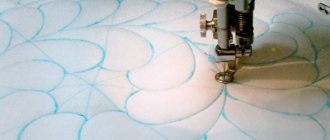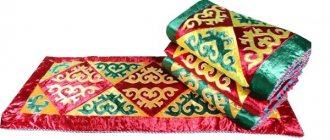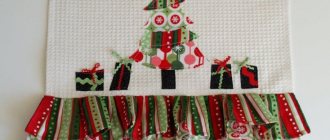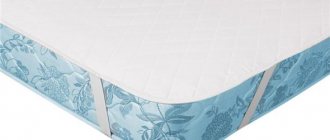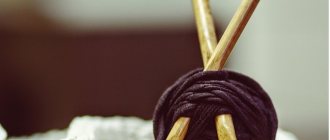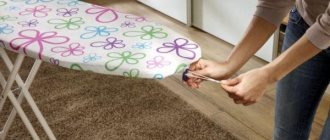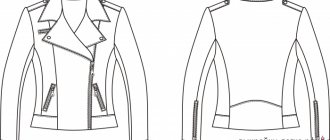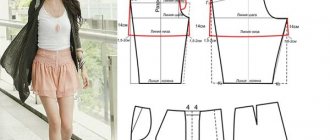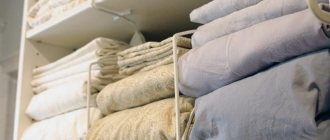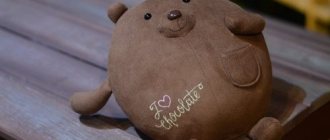With the arrival of a child in the family, caring mothers and fathers try to get the best for him. Young mothers prefer to make certain things themselves. It is not difficult for novice needlewomen to sew a baby blanket with their own hands, showing a little creativity.
Personalized baby blanket for a girl with your own hands - beautiful, stylish and comfortable
Cutting out a blanket
Take measurements before cutting. Dimensions are taken depending on the size of the crib and the purpose of the blanket. To make it gracefully hang from the crib, add an allowance of 15-25 cm to the width and length. There are standard sizes of blankets:
- 90x120 cm;
- 110x140 cm;
- 143x215cm.
There are non-standard sizes:
- 90x90 cm, blanket for stroller, cradle;
- 120x120 cm, blanket for discharge from the maternity hospital, for walks;
- 150x130 cm, blanket - sleeping bag in the shape of a bag, then useful as a simple blanket.
Make a quilt pattern by drawing a rectangle from your measurements, with a 1.5cm seam allowance on all four sides.
Sewing technique
Let's look at how to sew a baby blanket from padding polyester with your own hands, step by step.
Place the fabric on a flat surface, smooth it out, pin the pattern to it with pins and cut out according to the pattern
Cotton fabric detail with stars
Minky soft plush detail
Necessary materials
Choose fabric according to the following criteria:
- wear-resistant and durable, able to withstand repeated washing;
- natural and with antistatic effect (chintz, calico, linen, silk);
- not cause allergies in the baby;
- without toxic dyes;
- all layers must allow air to pass through well.
For the bottom of the blanket, choose a cotton fabric. It is absolutely natural, breathable, but not wear-resistant. Silk and twill are soft to the touch, but require very delicate care. The most acceptable options are cambric, satin, fleece, flannel, calico, bamboo fabric, which meets all the specified criteria. The top part of the blanket can be sewn from any fabric, as long as it is soft and natural.
The following fillers are used.
- Downy – lightweight; soft; air circulates through it, but clumps; it has a characteristic smell.
- Sherstepon – soft; absorbs moisture well and remains dry; It is not recommended to machine wash.
- Sintepon - light; does not provoke allergic reactions; washes well; not expensive.
- Hollow fiber – resistant to knocking down; very warm; does not deform during washing; more expensive than padding polyester.
- Bamboo fiber – meets all criteria; crumples.
The most popular types of filler are padding polyester and holofiber.
Calculate the amount of fabric as follows: take two lengths as measured, take into account a seam allowance of 1.5 cm on each side and 10 cm for shrinkage, i.e. total allowance is 13 cm. Calculate the amount of filler depending on the size of the blanket and the number of layers.
For sewing you will also need threads No. 40-60, machine needle No. 90-100, pins.
Where to start sewing a baby blanket
In order for the blanket to turn out well and your efforts not to be wasted, you need to correctly calculate the size of the blanket and arm yourself with all the necessary materials.
DIY baby blanket. Blanket size
You can choose the size of the blanket at your discretion, taking into account the age of your baby, the size of the crib and existing bedding:
- Babies from birth to three years old sleep in cribs for newborns. The standard dimensions of a mattress are 120x60 cm. The average size of a duvet cover for this age category is 120x90 cm. Therefore, the size of the blanket should correspond to its size. If you plan to use the comforter without the duvet cover, you may want to change the size slightly.
- Children from three to six years old sleep on children's beds with dimensions of 160x70 cm. The suitable size of a blanket for such a bed will be 140x110 cm.
- Children 5-6 years old feel comfortable on teenage beds with a mattress size of 200x90 cm. For this age, a slightly larger blanket is suitable - 215x143 cm.
Modern textile production has long gone beyond standards and produces bed linen and blankets of not quite typical sizes. Very often there are square and round blankets that can be transformed. Therefore, you can safely experiment with the size and shape of your homemade product.
Baby blanket of custom sizes for newborns:
- 90x90 cm - will become an invaluable thing for covering a baby in a cradle, and then, when the baby grows up, it will be useful for riding on a swing in the cold season.
- 120x120 cm - perfect for discharge, covering the baby during a walk. It can be laid on a changing table or used as an educational play mat if you decorate it with appliqués. But such a blanket will very soon become too small for your baby.
- 150x130 cm - this size is suitable for sewing a sleeping blanket. While the baby is small, you can fasten it, transforming it into a bag, and over time use it as a regular blanket.
DIY baby blanket. Product design and choice of materials
Making a blanket sometimes takes a lot of time and effort. The first thing the craftswoman pays attention to during the sewing process is the choice of materials that are safe for children and the aesthetic appearance of the product. But the main thing should always be the durability of the blanket, as well as the ability to care for it without losing its original appearance.
During operation, small troubles will occur in the form of spilled milk, juice or something else, and the baby will sweat under the blanket during illness. Therefore, the blanket will need to be washed from time to time. It is at this stage that many questions will arise that can be missed when sewing a blanket. In order not to ruin your many days of work after washing, it is better to immediately carefully think through the design of the blanket and sew it firmly, and then quilt it.
The blanket consists of three basic elements - lining, filling and cover. But, some types of blankets may not have an insulating layer. Each part of the blanket requires certain types of materials, which must meet the following criteria:
- Hypoallergenic - all consumables from fabric to threads should not provoke an allergic reaction in the baby.
- No toxic dyes - the drawing must be safe for the child. Before purchasing, always inquire about the availability of a certificate for the material. The design should not fade or have a strong smell.
- High wear resistance and mechanical strength - the blanket will be used frequently, so all materials must be resistant to friction, washing, stretching and other mechanical manipulations.
- Vapor and breathability - all layers of the blanket must allow air and sweat vapor to pass through. This will provide not only comfortable sleeping conditions, but will also protect the product from air stagnation, untidy odor and the proliferation of microorganisms (dust mites, mold, etc.).
- Natural origin of the fabric - only natural fabrics are recommended for the baby, for example, calico, linen, silk.
- Antistatic - it is better to sew the product from fabric with an antistatic effect, otherwise a highly electrified blanket will cause inconvenience.
To sew a tire, you can use any natural fabric, as long as it is soft to the touch and does not cause mechanical irritation to the delicate skin of the child. For such purposes, thin furniture fabric or raincoat fabric is also suitable if the blanket is intended for outdoor use.
It is quite appropriate to use cotton fabric for the lining. It fully allows air to pass through and does not lead to disruption of thermoregulation in the child, while it is affordable and completely natural. But it is not wear-resistant, wears out quickly, gets dirty easily and is very difficult to wash.
You can choose twill or silk. They are also breathable, pleasant to the touch, but too slippery. Therefore, if a child likes to spin in his sleep, it is better to find another option.
The most optimal and budget solution is to use bamboo fabric. It retains heat well, does not interfere with air microcirculation, retains its appearance for a long time, and does not cause allergies.
The choice of material for the underside of a blanket should be made taking into account the season in which it will be used. For a winter product, a baize, fleece, or calico are suitable, and for the warm season - cotton fabric (cambric, satin, volta).
The insert is added to a blanket to make it warmer. The filler used is:
- Synthetic winterizer is the cheapest silicone-based insulation. Blankets based on it are light and airy. But it cakes much faster, and when washed (if the liner is not quilted thickly) it becomes loose.
- Fleece is a warm, durable fabric for outerwear. It is heavier compared to padding polyester, but it does not stretch, does not bunch up and is easily washed without subsequent deformation.
- Holofiber is a fibrous material based on propylene. It is more expensive than synthetic winterizer, but has increased resistance to sale and is very warm. When washed, it is reluctant to deform, so a blanket based on it lasts longer.
Once you have already decided on the size and type of fabric, you should think about what appearance to give the blanket, what technique to sew it with and how to decorate it. If you adhere to traditional tastes, you can make a padding polyester or fleece blanket, and if you are a supporter of something exclusive, sew an unusual blanket from colorful scraps or knit an openwork blanket.
We sew a blanket for discharge
An original, beautiful, convenient and safe envelope for a newborn's discharge
The topic of how to sew a baby blanket for discharge from the maternity hospital is relevant in cool weather. Festive satin and lace envelopes will not work. For this purpose, a transformable blanket is sewn using the same method as a regular quilt on padding polyester. Sew two main parts of the blanket measuring 46x85 cm and 46x60 cm, two side flaps measuring 20x70 cm. Fasten the two main parts and two side flaps to the bottom of the blanket with Velcro, or sew satin ribbons. The top of the blanket can be decorated with lace or pleated ribbon. This blanket can easily be converted into a regular stroller blanket.
How to calculate the size correctly
To determine the parameters of a future product, it is worth finding out the standards used by manufacturers. For a crib for newborns up to 3 years old, choose blankets in the following sizes:
- 90 by 120 cm;
- 100 by 120 cm;
- 100 by 135 cm;
- 100 by 140 cm;
- 100 by 150 cm;
- 110 by 125 cm;
- 110 by 140 cm
A crib designed for a child 3-5 years old has blankets 160 by 100 cm and 160 by 120 cm. If the bed is of non-standard sizes, then it is better to sew the bedding yourself. This approach will allow you to create things suitable for a particular bed.
We sew a patchwork quilt with our own hands
Technique for creating a “Watercolor” blanket - combining square patches in the same color scheme, creating smooth transitions
The “Honeycomb” technique is suitable for a blanket made of hexagonal patches in any color scheme
Patchwork is very popular. This is not only an opportunity to use unnecessary scraps of fabric, but a fashionable interior accessory. Unique creations are created from scraps of fabric with figures of animals, cartoon characters, ships, flowers, fruits, etc. It's good to use old, bright children's clothes.
Patchwork technique “Checkerboard” - a blanket made of squares in two colors
The “Stripes” technique is suitable for narrow pieces - instead of squares, strips are used, sewn in a chaotic order
Patchwork Blanket Starter Kit
To sew a patchwork blanket you will need the following kit.
- Pieces of multi-colored fabric with different patterns.
- Fabric for the bottom of the blanket.
- Filler, for example synthetic winterizer.
- Sewing threads of different colors to match the shreds.
- Sewing machine.
- Iron.
- Ruler.
- Scissors or rotary cutter.
- Pins.
A patchwork blanket can be sewn from scraps of various shapes: square, diamond, triangle, stripes. Squares can be of different sizes. The pinnacle of craftsmanship is considered to be the creation of patchwork from a chaotic mixture of scraps. Sometimes this takes many months.
Sewing technique - patchwork
Today, the patchwork technique is very popular. Bright scraps of fabric of different sizes are used for needlework. You can pick up scraps with animals and cartoon characters.
Patchwork allows you to use clothes for a baby who has already become small. After all, it is often decorated with bright appliqués or embroideries.
Required material for patchwork needlework:
- bright scraps of fabric;
- material for binding;
- a set of threads;
- selected insulation;
- ruler;
- sewing machine;
- iron;
- seamstress scissors and a set of pins.
Sew a bonbon blanket
The “Bonbon” blanket is originally a decorative element of the style, the origin of which is based on the patchwork technique.
The bonbon blanket is a version of patchwork. Sewing it seems incredibly difficult at first glance. It is warm, unusually beautiful, bright. For it, one-color and multi-colored scraps are taken, forming a mosaic. The base fabric is drawn into squares with a side of 11 cm. Cut square pieces with a side of 17 cm are sewn into horizontal stripes, like in a patchwork blanket. The strip is sewn to the base as follows: using pins, the squares of the scraps are secured to the vertical lines of the base fabric, and a fold of excess fabric is placed in the middle of the square for lifting. The resulting voids are filled with holofiber, the squares are attached on three sides to the main fabric using a machine. The following rows are sewn to the bottom edge, continuing until the entire length is filled. The edges of the product are finished with bias tape.
Blankets of this type are sewn from separate ottoman pockets filled with holofiber
A simple knitted blanket for a newborn with a beautiful edging
To knit a beautiful blanket for a newborn, you don’t have to learn complex patterns; you can just knit the main fabric with a simple pattern and make an original edging.
Blanket size 50*60 cm
Materials:
- Yarn (90% cotton), 50g/180 m in three colors: orange-yellow, brick, red-orange, copper, walnut: total 350g
- Knitting needles No. 4
- Hook No. 3
We will use the following patterns when knitting:
- Basic: the number of loops is a multiple of 2 + 1 balance loop + 2 edges.
- Tying: the number of loops is a multiple of 4 + 3 loops + 2 chrome.
Knitting pattern for a baby blanket
- Cast on 139 loops, tie 5 cm high with a double elastic band. In the first row, alternate 1 knit stitch, 1 purl stitch. In the second row, knit the front loop, remove the purl one, leaving the thread in front of you. In the third row, knit the stitch that was slipped in the previous row, and slip the next one, leaving the thread in front of you. Repeat the pattern from the second row.
- Then knit the first and last loops with a double elastic band, 123 loops in the middle - with fancy knitting according to the pattern. For craftswomen who know how to knit, it will not be difficult to find any knitting pattern they like. Knit like this to a height of 83 cm.
- After this, knit 5 cm with double knitting, finish knitting by casting off the loops of the last row.
Makes a cute blanket for a newborn.
Knitted blue blanket complete with baby hat
This is how you can make a baby blanket or baby blanket with your own hands without spending a lot of money. It will warm you up, come in handy for walks in winter, decorate the interior, and serve as a play mat for your child.
Knitted blanket or plaid
If a child is born at the beginning of summer, he will need an openwork blanket or a knitted blanket, crocheted or knitted. This is a good alternative to stuffy baby blankets on hot days so that the baby does not suffer from heat rash.
Cotton yarn, bamboo or “summer” bobbins of mixed yarn on a hypoallergenic synthetic base are suitable for work.
When choosing a pattern, keep in mind that large relief patterns are not suitable - they are “imprinted” into the delicate skin of a sleeping baby. And although there are many different examples on the Internet with a chamomile field or voluminous hares, it is better to refuse such funny decor if you are knitting a blanket or a blanket for a newborn.
Experienced craftswomen recommend crocheted products; they are denser and more durable. They require more yarn, but when the baby grows up, the blanket can be used as a rug.
A winter wool product will not be as warm as a standard wadded blanket or padding polyester; in a warm apartment this will be enough if children sleep dressed in rompers and a vest.
